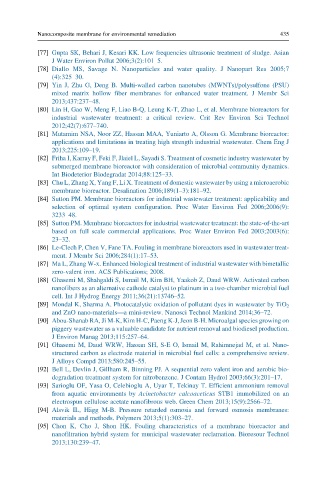Page 482 - Polymer-based Nanocomposites for Energy and Environmental Applications
P. 482
Nanocomposite membrane for environmental remediation 435
[77] Gupta SK, Behari J, Kesari KK. Low frequencies ultrasonic treatment of sludge. Asian
J Water Environ Pollut 2006;3(2):101–5.
[78] Diallo MS, Savage N. Nanoparticles and water quality. J Nanopart Res 2005;7
(4):325–30.
[79] Yin J, Zhu G, Deng B. Multi-walled carbon nanotubes (MWNTs)/polysulfone (PSU)
mixed matrix hollow fiber membranes for enhanced water treatment. J Membr Sci
2013;437:237–48.
[80] Lin H, Gao W, Meng F, Liao B-Q, Leung K-T, Zhao L, et al. Membrane bioreactors for
industrial wastewater treatment: a critical review. Crit Rev Environ Sci Technol
2012;42(7):677–740.
[81] Mutamim NSA, Noor ZZ, Hassan MAA, Yuniarto A, Olsson G. Membrane bioreactor:
applications and limitations in treating high strength industrial wastewater. Chem Eng J
2013;225:109–19.
[82] Friha I, Karray F, Feki F, Jlaiel L, Sayadi S. Treatment of cosmetic industry wastewater by
submerged membrane bioreactor with consideration of microbial community dynamics.
Int Biodeterior Biodegradat 2014;88:125–33.
[83] Chu L, Zhang X, Yang F, Li X. Treatment of domestic wastewater by using a microaerobic
membrane bioreactor. Desalination 2006;189(1–3):181–92.
[84] Sutton PM. Membrane bioreactors for industrial wastewater treatment: applicability and
selection of optimal system configuration. Proc Water Environ Fed 2006;2006(9):
3233–48.
[85] Sutton PM. Membrane bioreactors for industrial wastewater treatment: the state-of-the-art
based on full scale commercial applications. Proc Water Environ Fed 2003;2003(6):
23–32.
[86] Le-Clech P, Chen V, Fane TA. Fouling in membrane bioreactors used in wastewater treat-
ment. J Membr Sci 2006;284(1):17–53.
[87] Ma L, Zhang W-x. Enhanced biological treatment of industrial wastewater with bimetallic
zero-valent iron. ACS Publications; 2008.
[88] Ghasemi M, Shahgaldi S, Ismail M, Kim BH, Yaakob Z, Daud WRW. Activated carbon
nanofibers as an alternative cathode catalyst to platinum in a two-chamber microbial fuel
cell. Int J Hydrog Energy 2011;36(21):13746–52.
[89] Mondal K, Sharma A. Photocatalytic oxidation of pollutant dyes in wastewater by TiO 2
and ZnO nano-materials—a mini-review. Nanosci Technol Mankind 2014;36–72.
[90] Abou-Shanab RA, Ji M-K, Kim H-C, Paeng K-J, Jeon B-H. Microalgal species growing on
piggery wastewater as a valuable candidate for nutrient removal and biodiesel production.
J Environ Manag 2013;115:257–64.
[91] Ghasemi M, Daud WRW, Hassan SH, S-E O, Ismail M, Rahimnejad M, et al. Nano-
structured carbon as electrode material in microbial fuel cells: a comprehensive review.
J Alloys Compd 2013;580:245–55.
[92] Bell L, Devlin J, Gillham R, Binning PJ. A sequential zero valent iron and aerobic bio-
degradation treatment system for nitrobenzene. J Contam Hydrol 2003;66(3):201–17.
[93] Sarioglu OF, Yasa O, Celebioglu A, Uyar T, Tekinay T. Efficient ammonium removal
from aquatic environments by Acinetobacter calcoaceticus STB1 immobilized on an
electrospun cellulose acetate nanofibrous web. Green Chem 2013;15(9):2566–72.
[94] Alsvik IL, H€ agg M-B. Pressure retarded osmosis and forward osmosis membranes:
materials and methods. Polymers 2013;5(1):303–27.
[95] Chon K, Cho J, Shon HK. Fouling characteristics of a membrane bioreactor and
nanofiltration hybrid system for municipal wastewater reclamation. Bioresour Technol
2013;130:239–47.

